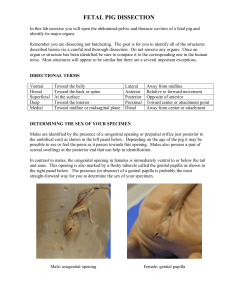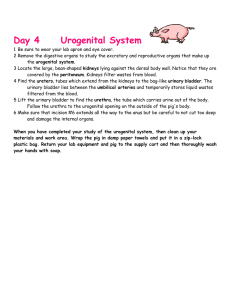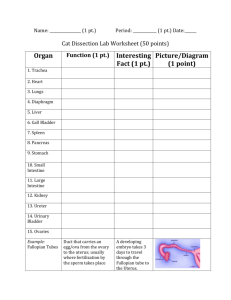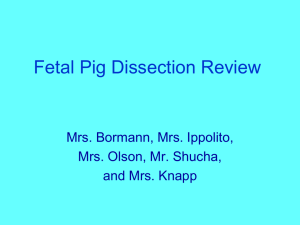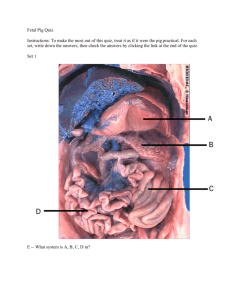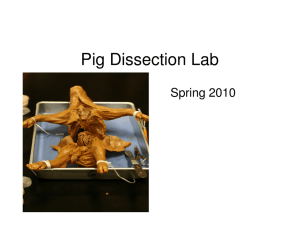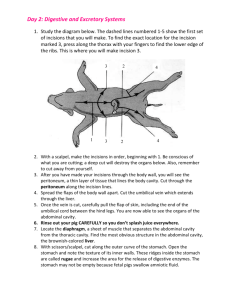Fetal Pig Dissection Lab Manual
advertisement
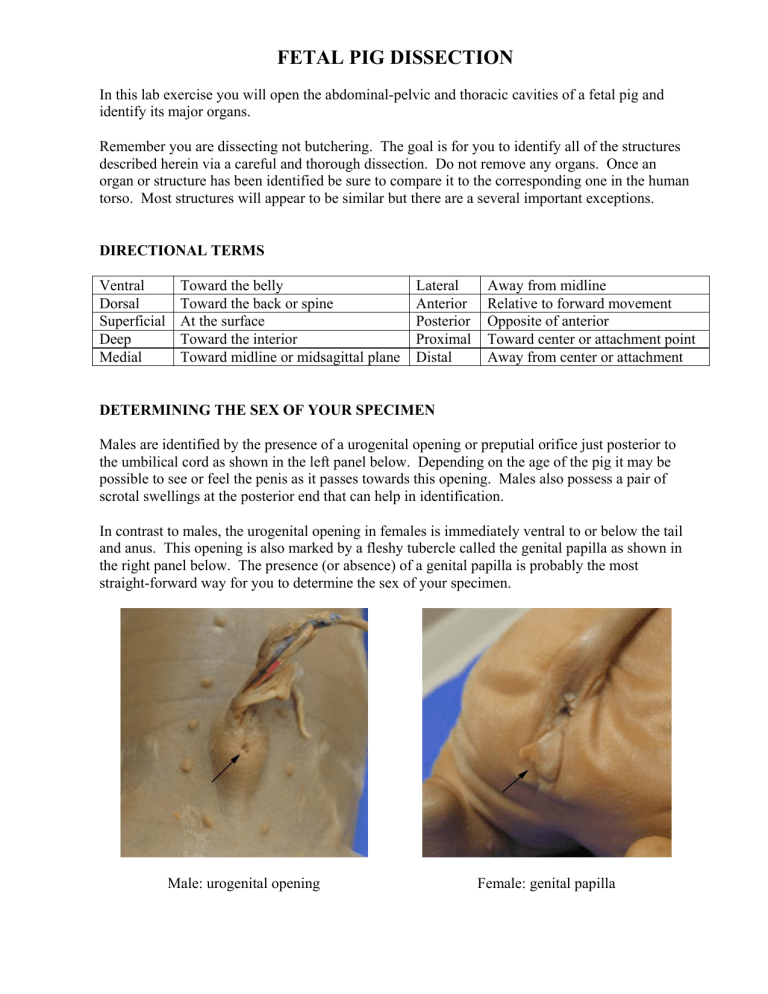
FETAL PIG DISSECTION In this lab exercise you will open the abdominal-pelvic and thoracic cavities of a fetal pig and identify its major organs. Remember you are dissecting not butchering. The goal is for you to identify all of the structures described herein via a careful and thorough dissection. Do not remove any organs. Once an organ or structure has been identified be sure to compare it to the corresponding one in the human torso. Most structures will appear to be similar but there are a several important exceptions. DIRECTIONAL TERMS Ventral Dorsal Superficial Deep Medial Toward the belly Toward the back or spine At the surface Toward the interior Toward midline or midsagittal plane Lateral Anterior Posterior Proximal Distal Away from midline Relative to forward movement Opposite of anterior Toward center or attachment point Away from center or attachment DETERMINING THE SEX OF YOUR SPECIMEN Males are identified by the presence of a urogenital opening or preputial orifice just posterior to the umbilical cord as shown in the left panel below. Depending on the age of the pig it may be possible to see or feel the penis as it passes towards this opening. Males also possess a pair of scrotal swellings at the posterior end that can help in identification. In contrast to males, the urogenital opening in females is immediately ventral to or below the tail and anus. This opening is also marked by a fleshy tubercle called the genital papilla as shown in the right panel below. The presence (or absence) of a genital papilla is probably the most straight-forward way for you to determine the sex of your specimen. Male: urogenital opening Female: genital papilla DISSECTION PART 1: ABDOMINAL AND PELVIC CAVITIES Securely fasten your specimen in a dissecting tray with its ventral side up. Cut two strings that are long enough to go completely around the dissecting tray. Tie one end of each string to the pig’s left fore- and hind legs (the ones toward your right). Bring each string under the tray to the opposite side. Enlist the help of your lab partner to hold the specimen’s legs as far apart as possible while you securely tie the strings to the corresponding right leg (on your left). Carefully use scissors or a scalpel to cut through the skin and musculature as shown in the figure on the right. Follow this diagram closely and work slowly to avoid damaging any organs. The two anterior-most cuts are made just under the rib cage and two sagittal incisions are made posterior to the umbilical cord. Exact placement of these cuts prevents damage to the diaphragm and the male’s penis respectively. Also be extremely careful when making the cuts into the male’s scrotum. The male reproductive organs are relatively superficial and can be easily damaged After completing these cuts you should locate and cut the umbilical vein, which connects the umbilical cord to the liver. The two flaps of flesh on either side can either be pinned back or cut off. You may also need to rinse and/or drain the preservative fluid, coagulated blood and latex from the abdominal-pelvic cavities. ABDOMINOPELVIC ORGANS COMMON TO BOTH SEXES Locate each of the following organs in your fetal pig. Observe the relative position, size, color and consistency for each. Remember to compare your observations with the atlas and human torso model and then check the box. 1. Diaphragm: thin muscular sheet that divides the thoracic and abdominal cavities. Aids in respiration or breathing. 2. Liver: large brown lobed structure located at the anterior end of the abdominal cavity. It metabolizes many drugs (including alcohol) and makes a substance similar to detergent for fat digestion called bile. 3. Gall bladder: small sac-like structure located underneath the right part of the liver. It collects bile, which is sent to the initial portion of the small intestine (duodenum) via the cystic and common bile ducts. 4. Stomach: a pouch shaped organ that rests just underneath the liver in the upper left quadrant. It is responsible for storing food and prepares it for digestion. 5. Spleen: thin flat organ in the pig that lies along the left lateral margin of the stomach toward the extreme left side. Looks like a flat worm or leech. The spleen is involved with maturation and processing of immune cells that protect the body. 6. Duodenum: the initial segment of the small intestine, which is located immediately after the stomach (straight part). It is a major location for food digestion. 7. Esophagus: located at top of the stomach near diaphragm. It functions in swallowing 8. Pancreas: Bumpy yellowish-brown gland located along bottom of the stomach and extending to the duodenum. It looks like “creamed corn”. The pancreas makes digestive enzymes, which are carried by the pancreatic duct to the duodenum. The pancreas also makes the hormone insulin, which promotes sugar uptake from blood. 9. Mesentery: thin sheets of tissue that hold the internal organs in place and provide them with a blood supply and nervous input. 10. Ileum: longest and most distal region of the three parts of the small intestine (curly part). Further digestion occurs and nutrients are absorbed here. 11. Cecum: a blind sac or “dead end” branch off of the large intestine. It looks somewhat like a crooked finger. It is found just below the juncture of the distal end of the ileum and the proximal end of the large intestine. 12. Appendix: in humans the appendix is located directly off the cecum. Do pigs have an appendix or not? 13. Large intestine or spiral colon: as the name suggests this is a tightly wound coil of the large intestines. The large intestine reabsorbs water from digested food. 14. Rectum: this lies toward the lower back region of the pig and is firmly attached to the dorsal wall of the cavity. Indigestible materials are processed here by coliform bacteria and the remaining water is reabsorbed. The result is feces. The rectum opens to the outside via the anus. 15. Kidneys: two bean-shaped organs present on either side of the spine. The kidneys are covered by the peritoneal membrane and are thus located retroperitoneal. The kidneys excrete harmful substances from the blood and form urine. 16. Adrenal glands: these small glands are located at the anterior and medial surface of the kidneys. The adrenals have two separate parts that 1) regulate your metabolism and 2) produce the “adrenalin rush” you feel when frightened or angry. 17. Umbilical arteries: in addition to the umbilical vein that connected the umbilical cord to the liver there are two arterial vessels that connect to the lower part of the abdominal cavity. These vessels carry blood to the placenta where it picks up nutrients and oxygen. 18. Urinary bladder: a large flattened sac that lies between the two umbilical arteries. It stores the urine. 19. Ureters: two thin retroperitoneal tubes that connect the kidneys to the urinary bladder and enables urine flow. 20. Urethra: the large tube that exits off the bottom of the urinary bladder. The bladder must be pulled up and the urethra can be separated from the surrounding tissue. The urethra enables urine to flow from the urinary bladder to the urogenital opening. IDENTIFY STRUCTURES NUMBERED ABOVE 1.__________________________________ 8.__________________________________ 2.__________________________________ 9.__________________________________ 3.__________________________________ 10. _________________________________ 4.__________________________________ 11. _________________________________ 5.__________________________________ 12. _________________________________ 6.__________________________________ 13. _________________________________ 7.__________________________________ 14. _________________________________ REPRODUCTIVE ORGANS You are responsible for knowing both male and female anatomy so make sure you view both sexes of pigs. Locate each of the structures listed below and check the box when you have found it. Again it is important to compare your observations with human torso models. Male 1. Scrotal sacs: external pouch located at the posterior end of the male pig. Functions to keep sperm cooler during spermatogenesis. 2. Cremasteric pouch: The cremasteric pouch is a thin walled elongated sac extending across the ventral surface of the thighs. Found within the scrotal sac and inguinal canals, it contains the testes and epididymis 3. Testes: Open the distal end of the cremasteric pouch. The testis is the small smooth structure inside. They produce sperm cells. 4. Epididymis: Coiled structure attached to each testis. Sperm cells produced in the testes pass through the epididymis and into the ductus deferens or vas deferens. 5. Vas deferens: Small ducts or tubes that exit the epididymis, cross over the ureter and enter the urethra. The vas deferens functions as a conduit for maturing sperm and is also referred to as the ductus deferens. Vasectomies involve cutting this tube. 6. Penis: located in the flap with the umbilical cord. Cut away the skin to reveal it. Female 1. Ovaries: two small lentil-shaped organs located near the midline in the most posterior region of the abdominopelvic cavity. 2. Uterine horns: There are some important structural differences between the pig and human uteri. The pig uterus has two long horns that are designed to accommodate many neonates simultaneously, and its uterus is classified as “bicornate”. The human uterus is designed for a single neonate and is relatively small or “simplex”. Because of the exaggerated length of the porcine uterus the fallopian tubes, which carry eggs from the ovaries to the uterus, are relatively small. The two stringy (Ramon noodlelike) structures that connect the ovaries to the central structure are the uterine horns. 3. Uterus: Central structure where the pig’s uterine horns unite. Carefully cut through the pelvic muscles and cartilage along the midline until you have a clear view of the uregenital organs and rectum as they exit the pelvic floor as shown in the figure on the next page. 4. Vagina: Muscular tube that connects the uterus to the urogenital sinus. 5. Urogenital sinus: The vagina and urethra open into a common tube that serves both reproductive and urinary functions in female pigs. This is different from human females where the vagina and urethra exit the body via separate openings. MALE REPRODUCTIVE SYSTEM FEMALE REPRODUCTIVE SYSTEM DISSECTION PART 2: NECK AND THORACIC CAVITY Carefully cut around the lateral edges of the diaphragm. Then use scissors to make the additional cuts through the skin, ribs and muscles as shown in the figure on the right. Work slowly and follow this diagram closely to avoid damaging any organs. This is especially important in the neck region where the thyroid gland and thymus are located within the surface musculature. Spread the fore legs wide apart and crack the ribs dorsally to get an optimum exposure of the thoracic cavity. Locate each of the structures listed below and check the box when you have located it. Once again remember to compare your observations with human torso models. 1. Thymus gland: located on the anterior surface of the heart slightly to the left of midline. The thymus also extends forward into both sides of the neck. The difference in size between the fetal pigs and humans is due to age not species. All fetuses have an enormous thymus, which gradually shrinks throughout life. Like the spleen, the thymus contains immune cells which function to protect the body. 2. Pericardium: Thin serous membrane beneath the thymus and covering the heart. 3. Heart: Cut through the pericardium and the heart will be visible. The heart pumps blood to the body through the aorta, which is the muscular tube visible at the anterior end of the heart. It also pumps blood to the lungs via the pulmonary arteries. 4. Lungs: Lobed spongy structures located on either side of the heart. Functions in respiration by enabling gas exchange between the atmosphere and body. 5. Bronchial tubes: Y-shaped tubes that connect the two lungs to the trachea and to each other. 6. Trachea: Relatively easy to identify in the neck and thoracic cavity due to the presence of cartilage rings that give it a segmented appearance (looks worm- or centipede-like). These rings keep the thyroid from collapsing as it carries air. 7. Thyroid gland: Small brown-purple gland located in the neck region between the lobes of the thymus and superficial to the trachea. The thyroid is important in regulating metabolism. 8. Larynx: Located at the anterior end of the trachea it is also known as the “voice box”. 9. Esophagus: You can pull this muscular tube out from behind the trachea. Again, it functions in swallowing. IDENTIFY STRUCTURES NUMBERED ABOVE 1.__________________________________ 5.__________________________________ 2.__________________________________ 6.__________________________________ 3.__________________________________ 7.__________________________________ 4.__________________________________ 8.__________________________________
